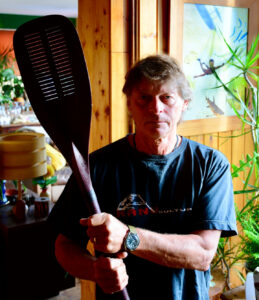Oscar Propulsion Review
There’s no escaping the fact that paddlesports are physiologically endurance-based, and their mechanics are leverage-focused. By their nature, standing while paddling puts unique demands upon the joints due to an extended lever arm length in relation to the lower hand and the centre of effort (the widest section) of the blade face.
The biomechanics of the entry, catch and pull phase, in particular, are akin to pole vaulting, where the setting of the paddle and resultant anchoring of the blade face, created by surprising water particles 700 times denser than air so they cannot escape the blade face, generates the resistance and force needed to pull you up level to the blade. Sprint racing will become an aerobic battle long after the anaerobic off-the-line moment has passed. It becomes a race of endurance, which applies to longer distances.
Many paddlers are easily fooled into perceiving that the more ‘loaded’ the paddle feels, the more significant the resultant hull speed must be generated; the paddler feels encouraged by the load while experiencing rapidly diminishing energy levels. In long outrigger canoe races of 60km or more, it’s not uncommon for crews to downsize their paddle size during the race, going narrower with smaller blade areas to maintain a consistent stroke rate and avoid burnout.
Even the most hardened canoeists who take up SUP recognise the feeling of overload in the shoulders and chest, especially when using conventional teardrop paddles and high-aspect straight-edged blades. Significantly, this has not been addressed with any genuine intent to lower the overload of the upper body, which fails to translate into any meaningful speed gains. More significantly, much of this load can still be attributed to ‘lift’ rather than forward momentum.
Oscar Propulsion has set out to address this issue and does not claim that their slotted technology will make you go faster. What can be said is that it will keep you fast for longer, which translates into greater distances travelled at a higher level of average speed. This dials into the notion that the paddler with the highest average speed wins the race, not the one who achieves the highest speed.
I’m not making my feedback complicated by comparing speeds or stroke rates between paddle types because, frankly speaking, this is not the primary matter at hand. The issue is purely about the generated feel and the knowledge that any composite blade face of any shape can be ‘slotted’. What the slots achieve, in essence, is a dampening of the catch phase of the stroke, whereby water particles are permitted to permeate the blade face under pressure.
This leads to several benefits; for one thing, the blade feels exceptionally well-balanced with minimal blade flutter for a negligible loss of grip. This can be explained by water escaping the blade face uniformly through the slots instead of randomly from the blade edges as the pressure diminishes. It makes blade entry a little noisy compared to a high-end, non-slotted blade face, even if it is quiet once under load and submerged. However, that’s not a negative; it is merely an observation. Once under load at the catch phase, there is no sense of overload on the upper body, which allows you to attack the stroke with vigour with lessened risk of injury and energy expenditure, which supports the endurance nature of paddling.
At the end of the stroke, the pressure is quickly dissipated, resulting in lessened pull-down and drag, which serves to drain your energy. This slightly reduces the shaft recoil, which is necessary for an encouraging recovery phase but is not a huge issue. It may call for more significant consideration of the shaft’s flex property to work in tune with the blade face load, which differs from non-slotted blade faces.
With all this said, the slotted blade face has substantial merit for the vast majority of stand-up paddlers in the interest of injury prevention, injury care, energy savings, and limiting overload of the upper body, more especially in the chest area, where it could lead to issues such as costochondritis, shoulder issues relating to rotator cuff shoulder issues, and elbow and wrist injuries.
SUP is rugged on the body, and slotted blade face technology offers a means to lessen the load without reducing the distance travelled over time, which is associated with lessening energy expenditure. While many gimmicks have come and gone over the years, this particular approach to a problem has substantial merit and should appeal to many paddlesport lovers looking to lessen the load.
Living legends: Steve & Mandy West – Stand up Paddle Mag, February 2022
Steve West is one of the world’s foremost ocean sports writers, educators, and athletes, with a career spanning some 50 years. He is a two-time winner of the Molokai Hoe and has participated in many international events, including being a runner-up in the Catalina Crossing. 2010 Commissioned to write Adventure Activities Licensing Authority UK SUP Good Practice Guide 2011 Commissioned to write Level Two Academy of Surfing (ASI) Australia SUP Exposed Waters Course Content 2011 Commissioned to write ASI SUP Water Rescue Course Content 2012 Released, Stand Up Paddle – A Paddlers Guide Book 2012 Commissioned to write Level Three ASI SUP Downwind Course Content 2013 Co-founder of the Water Skills Academy UK 2014 Released OC1 – A Paddlers Guide Book and Released V1 – A Paddler Guide Book, Winner of World Paddler Awards for Media 2015 Admitted into the World Paddle Academy 2013 – 2022 Lead Designer and Brand Manager Mistral International.

